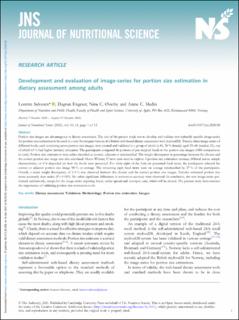| dc.contributor.author | Salvesen, Lorentz | |
| dc.contributor.author | Engeset, Dagrun | |
| dc.contributor.author | Øverby, Nina Cecilie | |
| dc.contributor.author | Medin, Anine Christine | |
| dc.date.accessioned | 2021-04-26T10:37:17Z | |
| dc.date.available | 2021-04-26T10:37:17Z | |
| dc.date.created | 2021-01-13T11:38:43Z | |
| dc.date.issued | 2021 | |
| dc.identifier.citation | Salvesen, L., Engeset, D., Øverby, N. C. & Medin, A. C. (2021). Development and evaluation of image-series for portion size estimation in dietary assessment among adults. Journal of Nutritional Science (JNS), 10. | en_US |
| dc.identifier.issn | 2048-6790 | |
| dc.identifier.uri | https://hdl.handle.net/11250/2739534 | |
| dc.description.abstract | Portion size images are advantageous in dietary assessment. The aim of the present study was to develop and validate new culturally specific image-series for portion size estimation to be used in a new Norwegian version of a British web-based dietary assessment tool (myfood24). Twenty-three image-series of different foods, each containing seven portion size images, were created and validated in a group of adults (n 41, 58 % female) aged 19–44 (median 23), out of which 63 % had higher (tertiary) education. The participants compared 46 portions of pre-weighed foods to the portion size images (1886 comparisons in total). Portion size estimations were either classified as correct, adjacent or misclassified. The weight discrepancy in percentage between the chosen and the correct portion size image was also calculated. Mann–Whitney U tests were used to explore if portion size estimation accuracy differed across sample characteristics, or if it depended on how the foods were presented. For thirty-eight of the forty-six presented food items, the participants selected the correct or adjacent portion size image 98 % on average. The remaining eight food items were on average misclassified by 27 % of the participants. Overall, a mean weight discrepancy of 2⋅5 % was observed between the chosen and the correct portion size images. Females estimated portion size more accurately than males (P = 0⋅019). No other significant differences in estimation accuracy were observed. In conclusion, the new image-series performed satisfactorily, except for the image-series depicting bread, caviar spread and marzipan cake, which will be altered. The present study demonstrates the importance of validating portion size estimation tools. | en_US |
| dc.language.iso | eng | en_US |
| dc.publisher | Cambridge University Press | en_US |
| dc.rights | Navngivelse 4.0 Internasjonal | * |
| dc.rights.uri | http://creativecommons.org/licenses/by/4.0/deed.no | * |
| dc.title | Development and evaluation of image-series for portion size estimation in dietary assessment among adults | en_US |
| dc.type | Peer reviewed | en_US |
| dc.type | Journal article | en_US |
| dc.description.version | publishedVersion | en_US |
| dc.rights.holder | © 2021 The Author(s) | en_US |
| dc.subject.nsi | VDP::Medisinske Fag: 700::Helsefag: 800::Ernæring: 811 | en_US |
| dc.source.volume | 10 | en_US |
| dc.source.journal | Journal of Nutritional Science (JNS) | en_US |
| dc.identifier.doi | https://doi.org/10.1017/jns.2020.58 | |
| dc.identifier.cristin | 1870491 | |
| dc.relation.project | Universitetet i Agder: 689019 | en_US |
| cristin.qualitycode | 1 | |

